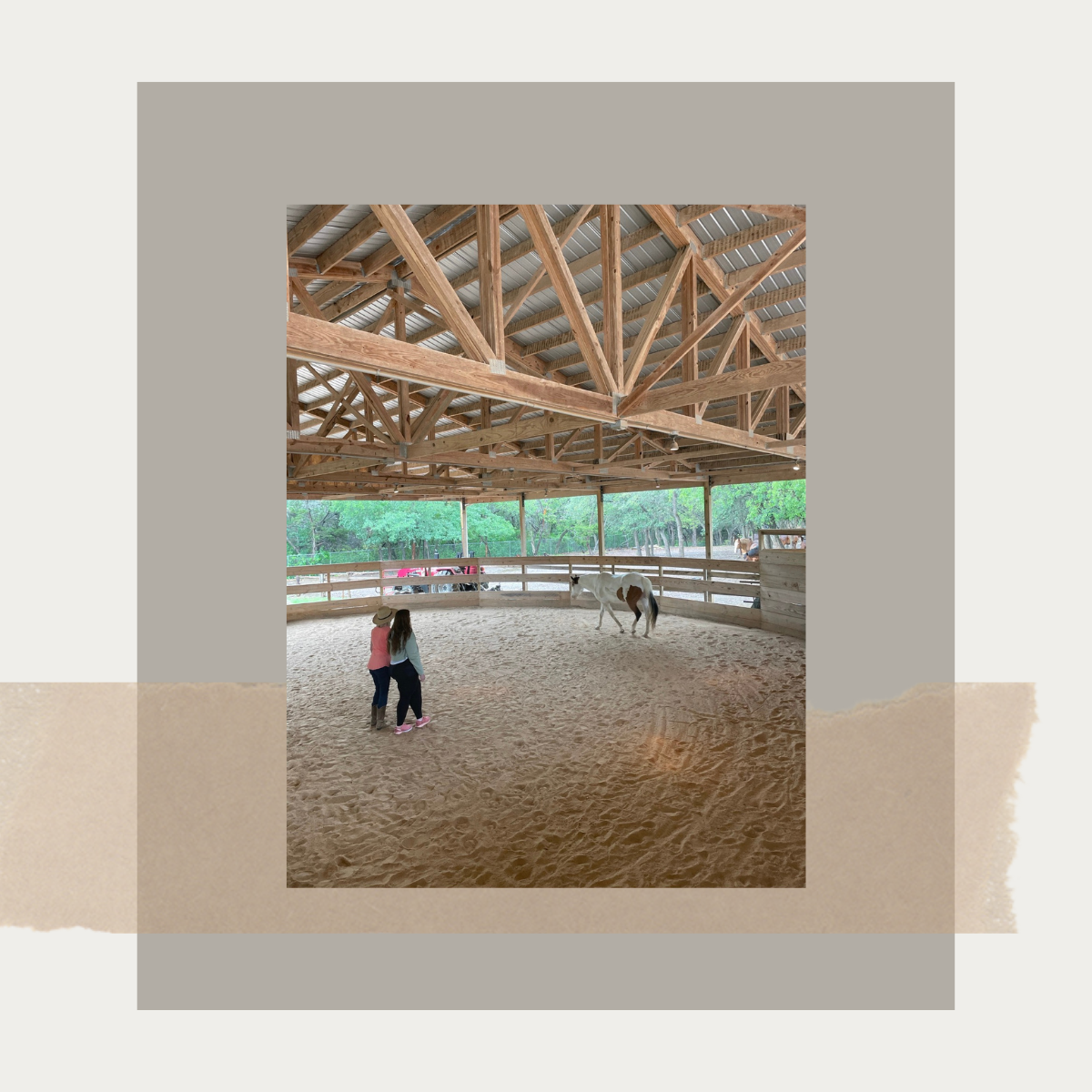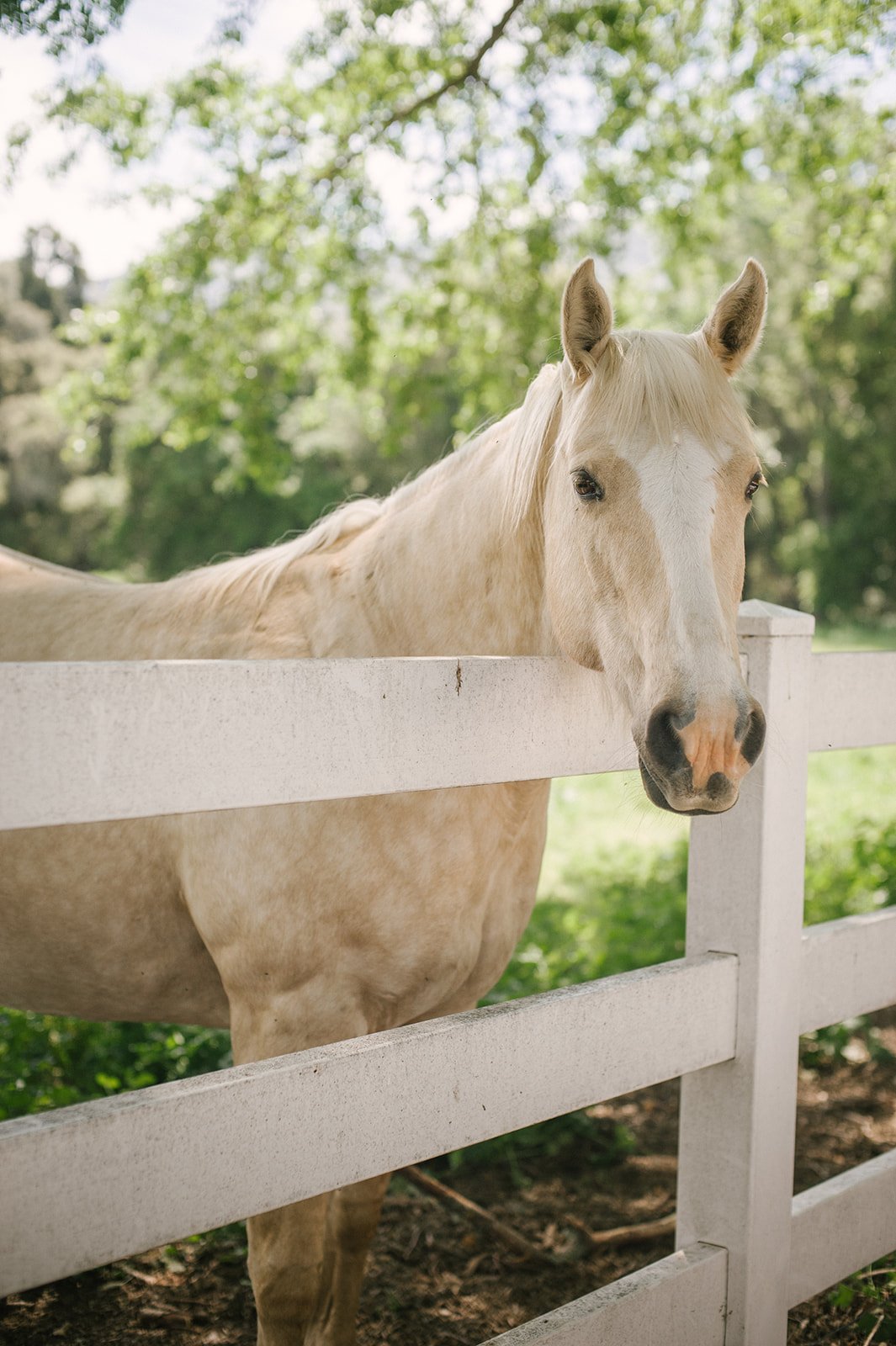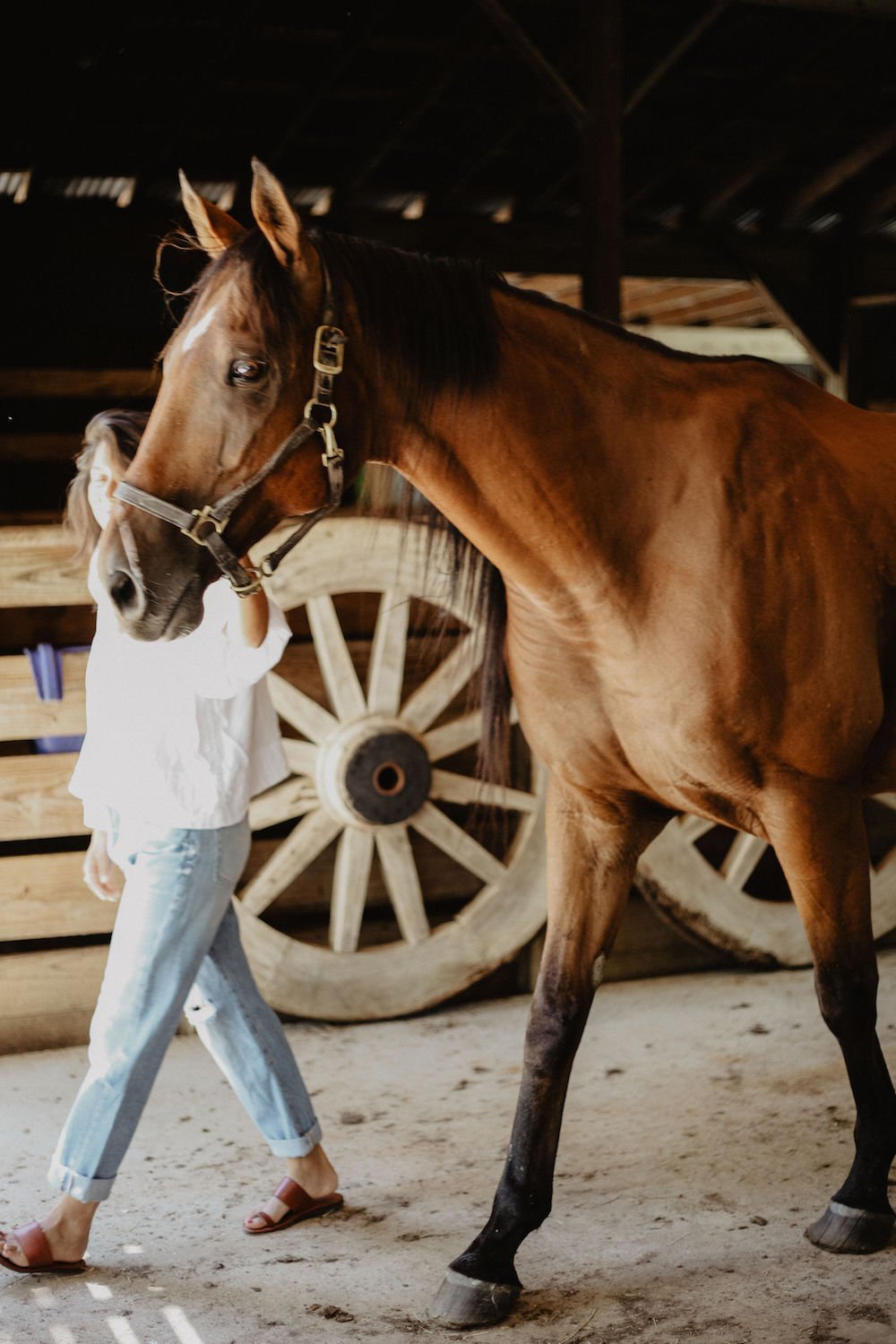Last month, I learned about the healing power of horses through an Equine Therapy activity at Miraval Austin called Common Ground. My sister and I were scheduled for the resort’s obstacle course, but with rain in the forecast, we decided to try something unique and a little more chill. Scanning through the options, the Equine activities caught my eye. Having had only one experience in my life with horses—an almost traumatic one with an especially feisty horse—my interest was piqued when I read that this experience would be unmounted. The description read:
Experience the powerful dynamics of non-verbal communication and how this influences your ability to lead yourself and others. In this unmounted activity, you will move with a horse around the pen, engaging tools of communication, collaboration, and creativity without speaking or touching. The insights and skills you discover may apply equally to personal and professional relationships.
I turned to my sister and said, “We can always do another obstacle course, but how many times will we have an opportunity to engage with horses in this capacity?” We were both sold, but neither of us expected how emotional and beautiful the experience would be.
We shuttled over to the farm across from the property, where our therapist and guide Paula Basden, Miraval Austin’s Equine Specialist, gathered our group of five to chat about the experience ahead. She explained what our time in the arena would be like: 20 minutes connecting with the horse and getting them to move in a variety of ways, all through non-verbal communication.
Equine therapy is about showing your horse what you want them to do, without saying a word. Horses pick up on energy and instincts, and if you’re not being honest or intentional with what you want, they disconnect.
I was nervous. Communicating non-verbally with an 800 pound horse in an enclosed space made me feel really small, yet it turns out, horses are often even more afraid. As I walked into the arena, my horse Pepper immediately dropped to the dirt and started to roll around. Paula turned to me with a smile, “Well this is just lovely. She feels safe with you. To drop to the ground is extremely vulnerable as it takes a horse a lot of effort to get up and escape danger. She feels safe.”
From there, I was overcome with emotion. As my eyes filled with tears, Pepper came straight over for an embrace. I had never been this close to a horse unmounted, and I could tell that Pepper could see I was in a place of vulnerability. When I was being honest, Pepper got close and embraced me. When I was unsure, she kept her distance.
One of these times, Paula asked what I was thinking about. I said, “I’m thinking about Pepper, how is she doing? I’m a stranger in her space. Is she scared? Is she nervous? What should I be doing with my body, my hands?”
Paula remarked, “You are the host of a lot of people’s emotions in spaces, aren’t you? Always wondering and worried about how everyone else is doing.”
As a matter of fact, she was completely on point. Paula encouraged me to think about how I felt in the moment–to consider my own needs. What did I need? After a moment, I realized that no one had really asked me that before; I come from a long lineage of “fixers” versus “askers,” so it was nice to hear.
“I’d love to just connect with the horse—an embrace.”
Paula told me to close my eyes and think about that. I kept them closed for about 20-30 seconds and when I looked up, Pepper was standing right beside me waiting for an embrace. I didn’t even hear her come near, but I could feel her.
My time with Paula and Pepper was really special. And I realized: nearly everyone learns something when they’re in the arena. But it’s what you do with that learning outside the arena that will impact your life the most.
If you’re interested in trying equine therapy, our guide Paula shared a bit about her experience with the healing power of horses.

How did you get into Equine Therapy?
After a long career as a labor and delivery nurse, I became aware of how new moms were struggling to thrive. They were simply surviving by addressing their physical and emotional health but had little or no knowledge of how to address their emotional, mental, and spiritual health. When I assisted them in paying attention to and addressing needs in these areas, their overall health improved, but more importantly, their ability to thrive and live fully was greatly increased. I’ve been a horse enthusiast all my life (read: horse nut) and so finding a career in which I could assist people in living more fully by using a relationship with a horse, I was hooked. I then went through the certification and training process.
Who is the best candidate for Equine Therapy?
There are no pre-requisites, but I would say the best candidate is simply a person who is curious about how they show up in their relationships, both with themselves and other people. I’ve worked with clients who are petrified of horses with absolutely no horse experience and clients who have ridden all their lives and clients anywhere in between.
Equine therapy is for anyone willing to be open to changing their perspective on how they show up in life.
Being willing to look at what we are unwilling to feel and how that is affecting our relationships takes a lot of courage. Horses help us to find that courage in a way that is less threatening than many other therapies. The horses have no judgment, so it is a safe place to feel vulnerable. Working with horses involve a relationship, and in relationships, emotions arise. What we do with those emotions is usually based upon the patterns we learned to survive—patterns that kept us from being hurt emotionally or physically. Unfortunately, those patterns that originally kept us safe usually become barriers in creating the connected relationships we desire in our adult lives.
Horses help us to see that the stories we tell ourselves do not have to define our lives.
What is involved in an Equine Therapy Session? How often do people usually do this?
Equine therapy can be a one-time experience or an ongoing set of sessions depending upon the intention of the client and the work they are trying to do. It can be done 1:1 with a facilitator and one horse or can be done in a group, and each has its own benefit. Even a one-time session can open up a space that clients have kept closed for years, or simply allow them to acknowledge that what they think has been tucked away, is actually the world they live in. Group sessions can be helpful in seeing how others are challenged in knowing what they are actually thinking and feeling in relationships and gives us all permission to simply be human.
Working with a trained therapist/facilitator for several sessions—usually once a week for several weeks—allows clients to go deeper into their inner world. Equine therapy can be a great adjunct to those who are working in traditional therapy. Often one or two sessions with a horse can be equal to several in usual talk therapy because the horses help us to feel our way out instead of thinking our way out.
How does Equine Therapy help?
Equine therapy is simply a way to become more self-aware. Emotion and cognition, undefined and unexplored, drive every decision you make. As an adult, you either learn to understand yourself better, or you double down on whatever behaviors you’ve found to help you not feel. When you do that—when you get better at not feeling—you cause more pain and suffering not only to yourself but to those around you.
Working with a horse can help you see that looking at how you respond actually gives you more agency over your life, which always leads to better mental health.
We call it self-regulation—the ability to manage our emotions when they come up instead of being controlled by them. Responding to life with our thinking brain instead of our survival brain allows us to show up making healthier choices and function better in relationships. It can help with any kind of addiction, depression, anxiety, inability to create healthy boundaries, challenges in relationships with family, friends, and co-workers. The hard parts of our lives do not have to become the landscape where we dwell. We can elevate the darkness of our lives (we all have it) as a catalyst to becoming the hero of our own story.

Are there specific conditions that respond especially well to equine therapy?
Equine therapy can be used for a variety of mental health conditions. There are programs that deal specifically with drug and alcohol addiction, eating disorders, PTSD, anxiety, and depression. When I say mental health I’m not just saying those with a specific diagnosis. Anyone who struggles with symptoms that they can’t seem to work themselves out of can be helped by working with horses.
Covid has proven to us that there is a part of everyone that needs attention that goes beyond what we can see with our eyes or measure with our blood pressure cuffs. We need connection—I think we are hungry for it, even before covid. Connection is where we find meaning and purpose. Why? Because those mental health challenges can usually be traced to what we are feeling and thinking, and we as humans have gotten our Ph.D. in not knowing what we are feeling and thinking.
How about team building?
Equine work is phenomenal at team building and leadership within the context of our work lives. I believe that the pursuit of leadership and functioning at our best within a team requires the pursuit of finally growing up… and we must be willing to work with that which arises in that pursuit.
Leadership requires an authentic dive into the chaos of our lives. This work goes beyond the why of what you do and often goes straight to who you are, which is valuable insight when you are leading a team or part of one.
How much does Equine Therapy cost?
Outside of Miraval, equine therapy ranges between $150 to $200 per session (can be higher). The cost has been a challenge in the past, but that challenge is decreasing as it is now an accepted modality of treatment that insurance has recognized. In some places, clients can now get one or two or more sessions covered. Some centers may have grants or ways of financing the sessions to make them more accessible to groups who cannot afford it. When I have worked at treatment centers, it is included in the treatment. Also, the non-profit centers that deal with people who need but cannot afford mental health treatment are adding equine therapy to their treatment modalities.
The Common Ground: Self-Leadership for Effective Communication equine therapy session costs $105 and is available at all three Miraval Resort locations.







